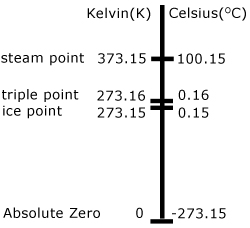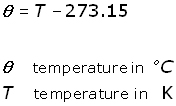Home >> Thermal, thermometry
temperature |
What is temperature?
Temperature is a measure of the average kinetic energy of the particles making up the substance being examined.
Temperature must not be confused with heat.
Heat is the amount of vibrational energy contained in a particular mass.
Fixed Points
For any temperature scale, it is necessary to have two fixed points. These are temperatures at which particular physical properties manifest themselves eg melting, boiling.
Common fixed points:
ice point - temperature when pure water ice is in equilibrium with liquid water at standard atmospheric pressure (76mm Hg).
steam point - temperature when pure liquid water exists in equilibrium with water vapour at standard atmospheric pressure.
triple point* - temperature when pure water ice, pure liquid water and pure water vapour exist in equilibrium.
* there are triple points for many other substances besides water
Temperature scales are divided into a specific number of degrees between the two fixed points.
The gap between the upper and lower fixed points is called the fundamental interval.

As a matter of historical interest, the Fahrenheit scale was founded on the following fixed points:
lower fixed point 0 deg.(0oF) - the coldest salt mixture temperature attained
higher fixed point 100 deg.(100oF) - horse blood temperature
The Kelvin (Absolute) temperature scale
This scale uses the the triple point of water as the upper fixed point and absolute zero (zero molecular motion) as the lower fixed point.
The triple point of water is assigned the temperature 273.16K while the the ice point is 273.15K and the steam point 373.15K.

By definition one degree Kelvin is: 1 / 273.16 (approximately 0.00366) of the difference between absolute zero and the triple point of water.
The Celsius temperature scale
The Celsius scale was introduced to replace the Centigrade scale. The Centigrade scale had the melting point of ice as its lower fixed point and the boiling point of water as the upper fixed point, both measured at standard atmospheric pressure.
However, unlike the triple point of water, the melting point of ice cannot be measured with enough precision to make it an absolute marker.
The Celsius scale is closely related to the Kelvin scale.
By definition one degree Celsius is: 1 / 273.16 (approximately 0.00366) of the difference between absolute zero and the triple point of water.
This is the same definition as for a degree Kelvin. So a temperature change of 1K equates to a change of 1oC.
The two scales are also defined by the equation:

[ About ] [ FAQ ] [ Links ] [ Terms & Conditions ] [ Privacy ] [ Site Map ] [ Contact ]
